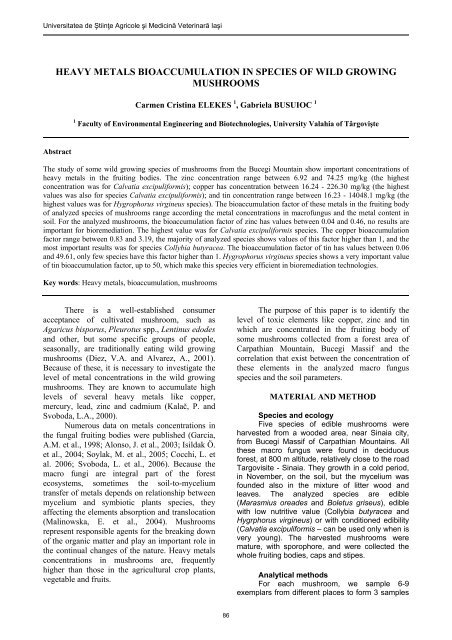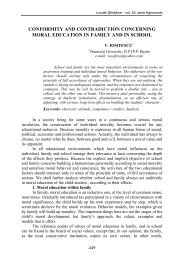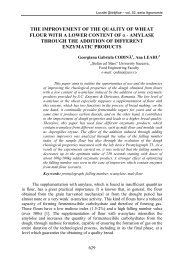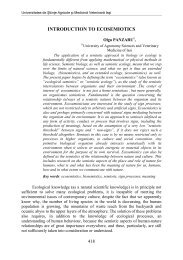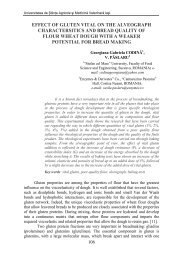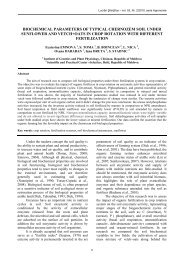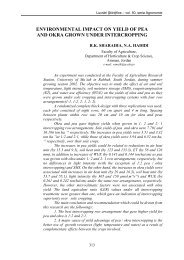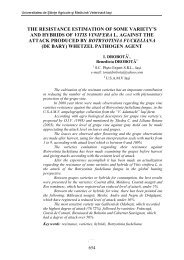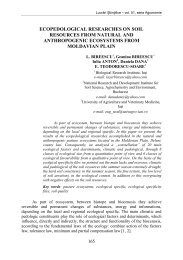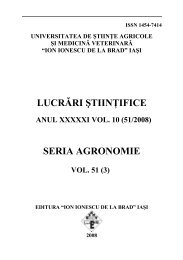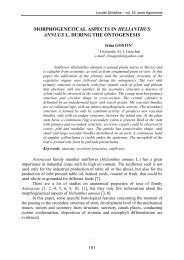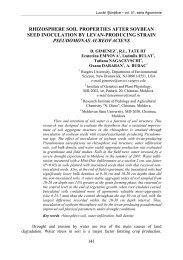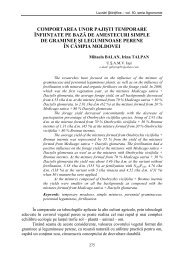heavy metals bioaccumulation in species of wild growing mushrooms
heavy metals bioaccumulation in species of wild growing mushrooms
heavy metals bioaccumulation in species of wild growing mushrooms
You also want an ePaper? Increase the reach of your titles
YUMPU automatically turns print PDFs into web optimized ePapers that Google loves.
Universitatea de Şti<strong>in</strong>ţe Agricole şi Medic<strong>in</strong>ă Veter<strong>in</strong>ară Iaşi<br />
HEAVY METALS BIOACCUMULATION IN SPECIES OF WILD GROWING<br />
MUSHROOMS<br />
Carmen Crist<strong>in</strong>a ELEKES 1 , Gabriela BUSUIOC 1<br />
1 Faculty <strong>of</strong> Environmental Eng<strong>in</strong>eer<strong>in</strong>g and Biotechnologies, University Valahia <strong>of</strong> Târgovişte<br />
Abstract<br />
The study <strong>of</strong> some <strong>wild</strong> grow<strong>in</strong>g <strong>species</strong> <strong>of</strong> <strong>mushrooms</strong> from the Bucegi Mounta<strong>in</strong> show important concentrations <strong>of</strong><br />
<strong>heavy</strong> <strong>metals</strong> <strong>in</strong> the fruit<strong>in</strong>g bodies. The z<strong>in</strong>c concentration range between 6.92 and 74.25 mg/kg (the highest<br />
concentration was for Calvatia excipuliformis); copper has concentration between 16.24 - 226.30 mg/kg (the highest<br />
values was also for <strong>species</strong> Calvatia excipuliformis); and t<strong>in</strong> concentration range between 16.23 - 14048.1 mg/kg (the<br />
highest values was for Hygrophorus virg<strong>in</strong>eus <strong>species</strong>). The <strong>bioaccumulation</strong> factor <strong>of</strong> these <strong>metals</strong> <strong>in</strong> the fruit<strong>in</strong>g body<br />
<strong>of</strong> analyzed <strong>species</strong> <strong>of</strong> <strong>mushrooms</strong> range accord<strong>in</strong>g the metal concentrations <strong>in</strong> macr<strong>of</strong>ungus and the metal content <strong>in</strong><br />
soil. For the analyzed <strong>mushrooms</strong>, the <strong>bioaccumulation</strong> factor <strong>of</strong> z<strong>in</strong>c has values between 0.04 and 0.46, no results are<br />
important for bioremediation. The highest value was for Calvatia excipuliformis <strong>species</strong>. The copper <strong>bioaccumulation</strong><br />
factor range between 0.83 and 3.19, the majority <strong>of</strong> analyzed <strong>species</strong> shows values <strong>of</strong> this factor higher than 1, and the<br />
most important results was for <strong>species</strong> Collybia butyracea. The <strong>bioaccumulation</strong> factor <strong>of</strong> t<strong>in</strong> has values between 0.06<br />
and 49.61, only few <strong>species</strong> have this factor higher than 1. Hygrophorus virg<strong>in</strong>eus <strong>species</strong> shows a very important value<br />
<strong>of</strong> t<strong>in</strong> <strong>bioaccumulation</strong> factor, up to 50, which make this <strong>species</strong> very efficient <strong>in</strong> bioremediation technologies.<br />
Key words: Heavy <strong>metals</strong>, <strong>bioaccumulation</strong>, <strong>mushrooms</strong><br />
There is a well-established consumer<br />
acceptance <strong>of</strong> cultivated mushroom, such as<br />
Agaricus bisporus, Pleurotus spp., Lent<strong>in</strong>us edodes<br />
and other, but some specific groups <strong>of</strong> people,<br />
seasonally, are traditionally eat<strong>in</strong>g <strong>wild</strong> grow<strong>in</strong>g<br />
<strong>mushrooms</strong> (Diez, V.A. and Alvarez, A., 2001).<br />
Because <strong>of</strong> these, it is necessary to <strong>in</strong>vestigate the<br />
level <strong>of</strong> metal concentrations <strong>in</strong> the <strong>wild</strong> grow<strong>in</strong>g<br />
<strong>mushrooms</strong>. They are known to accumulate high<br />
levels <strong>of</strong> several <strong>heavy</strong> <strong>metals</strong> like copper,<br />
mercury, lead, z<strong>in</strong>c and cadmium (Kalač, P. and<br />
Svoboda, L.A., 2000).<br />
Numerous data on <strong>metals</strong> concentrations <strong>in</strong><br />
the fungal fruit<strong>in</strong>g bodies were published (Garcia,<br />
A.M. et al., 1998; Alonso, J. et al., 2003; Isildak Ö.<br />
et al., 2004; Soylak, M. et al., 2005; Cocchi, L. et<br />
al. 2006; Svoboda, L. et al., 2006). Because the<br />
macro fungi are <strong>in</strong>tegral part <strong>of</strong> the forest<br />
ecosystems, sometimes the soil-to-mycelium<br />
transfer <strong>of</strong> <strong>metals</strong> depends on relationship between<br />
mycelium and symbiotic plants <strong>species</strong>, they<br />
affect<strong>in</strong>g the elements absorption and translocation<br />
(Mal<strong>in</strong>owska, E. et al., 2004). Mushrooms<br />
represent responsible agents for the break<strong>in</strong>g down<br />
<strong>of</strong> the organic matter and play an important role <strong>in</strong><br />
the cont<strong>in</strong>ual changes <strong>of</strong> the nature. Heavy <strong>metals</strong><br />
concentrations <strong>in</strong> <strong>mushrooms</strong> are, frequently<br />
higher than those <strong>in</strong> the agricultural crop plants,<br />
vegetable and fruits.<br />
The purpose <strong>of</strong> this paper is to identify the<br />
level <strong>of</strong> toxic elements like copper, z<strong>in</strong>c and t<strong>in</strong><br />
which are concentrated <strong>in</strong> the fruit<strong>in</strong>g body <strong>of</strong><br />
some <strong>mushrooms</strong> collected from a forest area <strong>of</strong><br />
Carpathian Mounta<strong>in</strong>, Bucegi Massif and the<br />
correlation that exist between the concentration <strong>of</strong><br />
these elements <strong>in</strong> the analyzed macro fungus<br />
<strong>species</strong> and the soil parameters.<br />
MATERIAL AND METHOD<br />
Species and ecology<br />
Five <strong>species</strong> <strong>of</strong> edible <strong>mushrooms</strong> were<br />
harvested from a wooded area, near S<strong>in</strong>aia city,<br />
from Bucegi Massif <strong>of</strong> Carpathian Mounta<strong>in</strong>s. All<br />
these macro fungus were found <strong>in</strong> deciduous<br />
forest, at 800 m altitude, relatively close to the road<br />
Targovisite - S<strong>in</strong>aia. They growth <strong>in</strong> a cold period,<br />
<strong>in</strong> November, on the soil, but the mycelium was<br />
founded also <strong>in</strong> the mixture <strong>of</strong> litter wood and<br />
leaves. The analyzed <strong>species</strong> are edible<br />
(Marasmius oreades and Boletus griseus), edible<br />
with low nutritive value (Collybia butyracea and<br />
Hygrphorus virg<strong>in</strong>eus) or with conditioned edibility<br />
(Calvatia excipuliformis – can be used only when is<br />
very young). The harvested <strong>mushrooms</strong> were<br />
mature, with sporophore, and were collected the<br />
whole fruit<strong>in</strong>g bodies, caps and stipes.<br />
Analytical methods<br />
For each mushroom, we sample 6-9<br />
exemplars from different places to form 3 samples<br />
86
Lucrări Şti<strong>in</strong>ţifice – vol. 53, Nr. 2/2010, seria Agronomie<br />
for each <strong>species</strong>, and the substratum near the<br />
mycelium, down to the depth <strong>of</strong> 5 cm. Both the<br />
samples <strong>of</strong> <strong>mushrooms</strong> and soil, and them<br />
process<strong>in</strong>g were did with plastic, glass and pottery<br />
<strong>in</strong>struments to avoid any metal contacts that can<br />
<strong>in</strong>fluence the results.<br />
After harvest<strong>in</strong>g, the <strong>mushrooms</strong> were clean<br />
up by the soil particles, dried at 60ºC and then<br />
gr<strong>in</strong>d<strong>in</strong>g to f<strong>in</strong>e powder. The soil samples were<br />
dried at 40ºC until the complete process, then<br />
gr<strong>in</strong>d<strong>in</strong>g to a f<strong>in</strong>e powder and sieved at 250 µm<br />
(conform SR ISO 11464).<br />
The Inductively Coupled Plasma - Atomic<br />
Emission Spectrometry method (ICP-AES), did the<br />
estimation <strong>of</strong> metallic content <strong>in</strong> the analyzed<br />
mushroom and them soil. For the analyzes with<br />
ICP-AES method, the biological samples<br />
(<strong>mushrooms</strong>) were m<strong>in</strong>eralized, <strong>in</strong> Bergh<strong>of</strong><br />
microwave digestor, by mixture with 10 ml <strong>of</strong> nitric<br />
acid concentrated 65% and 2 ml <strong>of</strong> hydrogen<br />
peroxide, and for the soil samples were done hot<br />
extractions with nitric acid 1:1.<br />
In present paper, the <strong>metals</strong> contents <strong>of</strong><br />
<strong>mushrooms</strong> were establish with a 110 Liberty<br />
Spectrometer type <strong>of</strong> Varian brand. To dis<strong>in</strong>tegrate<br />
the sample <strong>in</strong> constituents atoms or ions is used a<br />
plasma source, which will stir up them on superior<br />
energetic layer. They will revert to the <strong>in</strong>itial form<br />
by the emission <strong>of</strong> characteristic energy photon,<br />
emission recorded by an optical spectrometer. The<br />
radiation <strong>in</strong>tensity is proportional with each element<br />
concentration <strong>in</strong> the sample and is <strong>in</strong>tern<br />
calculated by a couple <strong>of</strong> calibration curves to<br />
obta<strong>in</strong> directly the measured concentration.<br />
The concentrations represent the mean <strong>of</strong><br />
many exemplars and are express <strong>in</strong> mg <strong>of</strong> metal<br />
related with kg <strong>of</strong> dry soil or plants. The m<strong>in</strong>imal<br />
detection limits <strong>of</strong> device range accord<strong>in</strong>g the<br />
analyzed element and is 0.4 mg/kg for Cu and Zn;<br />
0.6 mg/kg for Sn.<br />
RESULTS AND DISCUSSIONS<br />
The reported metal concentrations vary over<br />
a wide range with<strong>in</strong> the <strong>mushrooms</strong> <strong>species</strong>,<br />
because <strong>of</strong> many factors affect<strong>in</strong>g the accumulation<br />
rate. Density and depth <strong>of</strong> the mycelium liv<strong>in</strong>g <strong>in</strong><br />
the soil for several months or even years <strong>in</strong>fluence<br />
the <strong>metals</strong> contents <strong>in</strong> the fruit<strong>in</strong>g bodies. In<br />
addition, the soil properties, such as pH, redox<br />
potential, organic matter content, clay m<strong>in</strong>eralogy,<br />
caution exchange capacity <strong>of</strong> the soil phase,<br />
competition with other metal ions and composition<br />
<strong>of</strong> the soil solution <strong>in</strong>fluence the absorption <strong>of</strong><br />
<strong>metals</strong> <strong>in</strong> <strong>mushrooms</strong> (Angeles, Garcia M. et al.,<br />
2009).<br />
Some <strong>of</strong> the soil characteristics from Bucegi<br />
Massif on the sites where the fruit<strong>in</strong>g bodies were<br />
harvest are present <strong>in</strong> table 1. The humidity <strong>of</strong> the<br />
analyzed sites has the mean value <strong>of</strong> 47.53%<br />
because <strong>of</strong> the high ratio <strong>of</strong> leaf litter <strong>in</strong> the<br />
analyzed substratum, and the soil pH reaction is<br />
6.70 due to the high content <strong>of</strong> the biological<br />
material. The mean amount <strong>of</strong> trace <strong>metals</strong> <strong>in</strong> the<br />
soil was for Zn higher than the normal value for an<br />
organic soil (57-100 mg/kg), and did not reached<br />
this limit for Cu (1-115 mg/kg) (Kabata-Pendias,<br />
A. and Pendias, H., 1993).<br />
Table 1<br />
Humidity (%), pH and <strong>heavy</strong> <strong>metals</strong> contents (mg/kg) <strong>in</strong> the soil from the Bucegi Massif, near S<strong>in</strong>aia, Romania<br />
Soil parameters Mean SD Range M<strong>in</strong>imum Maximum<br />
Humidity 47.11 9.38 26.48 31.48 57.96<br />
pH 6.69 0.14 0.44 6.48 6.90<br />
Zn 130.80 26.59 67.71 94.63 162.34<br />
Cu 46.02 38.24 100.56 9.68 110.24<br />
Sn 495.14 457.47 1234.69 58.68 1293.37<br />
In the fruit<strong>in</strong>g body <strong>of</strong> <strong>mushrooms</strong>, the<br />
<strong>metals</strong> are accumulated <strong>in</strong> different quantities<br />
compar<strong>in</strong>g the cap and the stipe, accord<strong>in</strong>g the<br />
<strong>species</strong> and the metal concentrations <strong>in</strong> the<br />
substratum that the mushroom grew on. As we can<br />
see from table 2, the level <strong>of</strong> copper concentration<br />
<strong>in</strong> the stipe is higher than <strong>in</strong> the cap <strong>of</strong> fruit<strong>in</strong>g<br />
body, show<strong>in</strong>g a low mobility <strong>of</strong> copper <strong>in</strong>to the<br />
mushroom. The copper concentration <strong>in</strong> the cap <strong>of</strong><br />
some <strong>species</strong> <strong>of</strong> analyzed <strong>species</strong> <strong>of</strong> <strong>mushrooms</strong><br />
was under the detection limit <strong>of</strong> method (Boletus<br />
griseus and Hygrophorus virg<strong>in</strong>eus). The highest<br />
copper concentrations were founded <strong>in</strong> Calvatia<br />
excipuliformis <strong>species</strong>, as <strong>in</strong> cap, as <strong>in</strong> stipe <strong>of</strong><br />
fruit<strong>in</strong>g body (207.73 mg/kg, 244.86 mg/kg<br />
respectively).<br />
The z<strong>in</strong>c shows a higher mobility <strong>in</strong> the<br />
analyzed <strong>species</strong> <strong>of</strong> <strong>mushrooms</strong> than the copper,<br />
because <strong>of</strong> the highest concentration <strong>of</strong> this<br />
element <strong>in</strong> the cap <strong>of</strong> fruit<strong>in</strong>g body for the analyzed<br />
<strong>wild</strong> grow<strong>in</strong>g <strong>species</strong> <strong>of</strong> <strong>mushrooms</strong>. The levels <strong>of</strong><br />
z<strong>in</strong>c concentration <strong>in</strong> these <strong>species</strong> vary between<br />
10.98 mg/kg <strong>in</strong> Collybia butyracea <strong>species</strong> and<br />
92.19 mg/kg, the highest value show<strong>in</strong>g the<br />
superior part <strong>of</strong> Calvatia excipuliformis.<br />
The concentrations <strong>of</strong> t<strong>in</strong> <strong>in</strong> the cap are 2-5<br />
times the concentration <strong>in</strong> stipe <strong>of</strong> the fruit<strong>in</strong>g<br />
87
Universitatea de Şti<strong>in</strong>ţe Agricole şi Medic<strong>in</strong>ă Veter<strong>in</strong>ară Iaşi<br />
body. For the majority <strong>of</strong> <strong>species</strong>, the<br />
concentration <strong>in</strong> the stipe shows values under the<br />
detection limit <strong>of</strong> method. The most significant<br />
values <strong>of</strong> t<strong>in</strong> concentration has Hygrophorus<br />
virg<strong>in</strong>eus <strong>species</strong>, 18535.80 mg/kg <strong>of</strong> dry weight <strong>in</strong><br />
the cap and 9560.30 mg/kg dry weight <strong>in</strong> the stipe<br />
<strong>of</strong> mushroom, values 100 –fold higher than for the<br />
other analyzed <strong>species</strong>.<br />
Compar<strong>in</strong>g the concentration <strong>in</strong> the fruit<strong>in</strong>g<br />
body and the concentration <strong>in</strong> the substratum that<br />
the <strong>mushrooms</strong> grew on, we obta<strong>in</strong> the<br />
<strong>bioaccumulation</strong> factor, for each studied <strong>heavy</strong><br />
metal. The <strong>bioaccumulation</strong> factor represents the<br />
pollutant concentration <strong>in</strong> <strong>mushrooms</strong> compar<strong>in</strong>g<br />
with the environment concentration (<strong>in</strong> soil)<br />
(Scragg, A., 2005). For a plant or mushroom to be<br />
efficient tool <strong>in</strong> the polluted soil bioremediation,<br />
the <strong>bioaccumulation</strong> factor have to be higher than 1<br />
(Scragg, A., 2005).<br />
The <strong>bioaccumulation</strong> factor <strong>of</strong> the analyzed<br />
<strong>species</strong> is different accord<strong>in</strong>g the metal that is<br />
concentrate <strong>in</strong> the fruit<strong>in</strong>g body <strong>of</strong> <strong>mushrooms</strong><br />
(table 2). For copper, the <strong>bioaccumulation</strong> factor<br />
has higher than 1 values for the majority <strong>of</strong><br />
analyzed <strong>species</strong> <strong>of</strong> <strong>mushrooms</strong> (exception is<br />
Hygrophorus virg<strong>in</strong>eus <strong>species</strong>), tak<strong>in</strong>g values<br />
between 1.55 and 3.19 – the highest value is for<br />
Collybia butyracea <strong>species</strong>. The <strong>bioaccumulation</strong><br />
factor <strong>of</strong> z<strong>in</strong>c and t<strong>in</strong> <strong>in</strong> the fruit<strong>in</strong>g body <strong>of</strong><br />
analyzed <strong>species</strong> has sub unitary values, because<br />
the level <strong>of</strong> z<strong>in</strong>c and t<strong>in</strong> the fruit<strong>in</strong>g body <strong>of</strong> these<br />
<strong>species</strong> is lower than the concentrations <strong>in</strong><br />
substratum. An exception is Hygrophorus<br />
virg<strong>in</strong>eus <strong>species</strong> which has a <strong>bioaccumulation</strong><br />
factor <strong>of</strong> t<strong>in</strong> about 49.6, value that <strong>in</strong>dicate the<br />
hyper capacity <strong>of</strong> this <strong>species</strong> to absorb and<br />
accumulate Sn <strong>in</strong> its fruit<strong>in</strong>g body.<br />
Heavy metal concentrations <strong>in</strong> the fruit<strong>in</strong>g body <strong>of</strong> some <strong>wild</strong> grow<strong>in</strong>g <strong>mushrooms</strong> (mg/kg <strong>of</strong> DW), the<br />
concentration <strong>of</strong> <strong>metals</strong> <strong>in</strong> substratum (mg/kg) and the <strong>bioaccumulation</strong> factor for the analyzed samples<br />
Table 2<br />
Metal concentration Boletus griseus Collybia butyracea<br />
Calvatia<br />
excipuliformis<br />
Marasmius<br />
oreades<br />
Hygrophorus<br />
virg<strong>in</strong>eus<br />
Cap 0 27.33 ± 1.88 207.73 ± 3.53 106.41 ± 1.88 0<br />
Cu<br />
Stipe 32.48 ± 0.94 84.52 ± 0.97 244.86 ± 4.26 157.57 ± 1.30 45.40 ± 0.51<br />
Substratum 10.44 ± 0.84 17.49 ± 0.69 109.34 ± 0.89 65.59 ± 0.40 27.23 ± 0.57<br />
BF 1.5596 ± 0.0800 3.1977 ± 0.0511 2.069 ± 0.0186 2.0121 ± 0.0118 0.8335 ± 0.0082<br />
Cap 13.84 ± 0.35 11.62 ± 0.34 92.19 ± 0.21 46.27 ± 0.25 25.91 ± 0.39<br />
Zn<br />
Stipe 0 10.98 ± 0.23 56.31 ± 0.27 25.34 ± 0.35 15.40 ± 0.30<br />
Substratum 157.29 ± 2.70 131.52 ± 1.17 160.41 ± 1.83 95.39 ± 0.88 109.38 ± 0.97<br />
BF 0.0440 ± 0.0003 0.0859 ± 0.0013 0.4629 ± 0.0038 0.3753 ± 0.0007 0.1888 ± 0.0019<br />
Cap 48.67 ± 0.50 109.58 ± 1.81 32.47 ± 1.15 147.27 ± 1.66 18535.80 ± 73.83<br />
Sn<br />
Stipe 0 0 0 27.77 ± 0.39 9560.30 ± 32.59<br />
Substratum 188.35 ± 1.50 660.25 ± 4.74 60.59 ± 1.94 1283.40 ± 13.17 283.14 ± 2.57<br />
BF 0.1291 ± 0.0003 0.0829 ± 0.0007 0.2679 ± 0.0016 0.0681 ± 0.0002 49.6168 ± 0.2781<br />
Near the <strong>species</strong>, the soil characteristics<br />
<strong>in</strong>fluence <strong>in</strong> different way and range the<br />
accumulation <strong>of</strong> <strong>heavy</strong> <strong>metals</strong> <strong>in</strong> the fruit<strong>in</strong>g body<br />
<strong>of</strong> <strong>mushrooms</strong>. The concentration <strong>of</strong> copper <strong>in</strong><br />
<strong>mushrooms</strong> positively is <strong>in</strong>fluenced by the three<br />
studied parameters: <strong>heavy</strong> metal concentrations <strong>in</strong><br />
substratum, pH and soil moisture. The first two<br />
parameters have a strong <strong>in</strong>fluence (R 2 = 0.953, R 2<br />
= 0.815 respectively) (figure 1), which mean that<br />
the level <strong>of</strong> concentration <strong>in</strong> <strong>mushrooms</strong> has<br />
<strong>in</strong>crease with the <strong>in</strong>crease <strong>of</strong> copper content <strong>in</strong> soil<br />
and with the <strong>in</strong>crease <strong>of</strong> pH. In addition, an<br />
<strong>in</strong>crease <strong>of</strong> the soil moisture has positively<br />
<strong>in</strong>fluence the <strong>in</strong>crease <strong>of</strong> copper mobility and<br />
facilitates the absorption and accumulation <strong>of</strong> this<br />
<strong>heavy</strong> metal.<br />
The <strong>in</strong>fluence <strong>of</strong> soil characteristics on z<strong>in</strong>c<br />
accumulation <strong>in</strong> the fruit<strong>in</strong>g body <strong>of</strong> <strong>mushrooms</strong> is<br />
not significant, like for copper, and negative (R 2 =<br />
0.86) (figure 2). For an <strong>in</strong>crease <strong>of</strong> z<strong>in</strong>c content <strong>in</strong><br />
the soil with 20-25 mg/kg, the z<strong>in</strong>c concentration<br />
<strong>in</strong> the fruit<strong>in</strong>g body decreased with 10-15 mg/kg.<br />
The pH and soil moisture positively <strong>in</strong>fluenced the<br />
accumulation <strong>of</strong> z<strong>in</strong>c <strong>in</strong> the fruit<strong>in</strong>g body, but the<br />
correlation is not significant (R 2 < 0.7).<br />
For t<strong>in</strong>, the analyze <strong>of</strong> soil characteristics<br />
<strong>in</strong>fluences on the metal accumulation was done<br />
separately, for the all studied <strong>species</strong>, apart <strong>of</strong><br />
Hygrophorus virg<strong>in</strong>eus, because the t<strong>in</strong><br />
concentration for this <strong>species</strong> has too high level<br />
compar<strong>in</strong>g with the rest <strong>of</strong> analyzed <strong>species</strong>.<br />
88
Lucrări Şti<strong>in</strong>ţifice – vol. 53, Nr. 2/2010, seria Agronomie<br />
Figure 1 The <strong>in</strong>fluence <strong>of</strong> soil parameters on the copper concentration <strong>in</strong> the fruit<strong>in</strong>g body <strong>of</strong> <strong>wild</strong> grow<strong>in</strong>g<br />
<strong>mushrooms</strong><br />
Figure 2 The <strong>in</strong>fluence <strong>of</strong> soil parameters on the z<strong>in</strong>c concentration <strong>in</strong> the fruit<strong>in</strong>g body <strong>of</strong> <strong>wild</strong> grow<strong>in</strong>g<br />
<strong>mushrooms</strong><br />
89
Universitatea de Şti<strong>in</strong>ţe Agricole şi Medic<strong>in</strong>ă Veter<strong>in</strong>ară Iaşi<br />
Therefore, for Hygrophorus virg<strong>in</strong>eus<br />
<strong>species</strong>, the regression values show an <strong>in</strong>tra<strong>species</strong><br />
comparison <strong>of</strong> the soil parameters <strong>in</strong>fluences on<br />
the t<strong>in</strong> concentration <strong>in</strong> mushroom. As we can see<br />
<strong>in</strong> figure 3, the metal concentration <strong>in</strong> soil had a<br />
positive and significant <strong>in</strong>fluence on the t<strong>in</strong><br />
concentration <strong>in</strong> the fruit<strong>in</strong>g body <strong>of</strong> analyzed<br />
<strong>species</strong> <strong>of</strong> <strong>mushrooms</strong>. The same correlation is also<br />
for H. virg<strong>in</strong>eus <strong>species</strong>. The soil moisture and pH<br />
had a moderate significant <strong>in</strong>fluence on the t<strong>in</strong><br />
concentration <strong>in</strong> the fruit<strong>in</strong>g body (R 2 = 0.855, R 2<br />
= 0.647 respectively). The t<strong>in</strong> concentration <strong>in</strong><br />
mushroom <strong>in</strong>creased with the <strong>in</strong>crease <strong>of</strong> soil<br />
concentration and pH and when the moisture <strong>of</strong><br />
soil has decreased.<br />
Figure 3 The <strong>in</strong>fluence <strong>of</strong> soil parameters on the t<strong>in</strong> concentration <strong>in</strong> the fruit<strong>in</strong>g body <strong>of</strong> <strong>wild</strong> grow<strong>in</strong>g<br />
<strong>mushrooms</strong> (Series 1: Boletus griseus, Collybia butyracea, Calvatia excipuliformis and Marasmius oreades; Series 2:<br />
Hygrophorus virg<strong>in</strong>eus on secondary axis)<br />
The values <strong>of</strong> translocation factor <strong>of</strong> <strong>heavy</strong><br />
<strong>metals</strong> <strong>in</strong> the fruit<strong>in</strong>g body <strong>of</strong> analyzed <strong>mushrooms</strong><br />
vary accord<strong>in</strong>g with the <strong>species</strong>. For copper the<br />
values <strong>of</strong> translocation factor were zero for Boletus<br />
griseus and Hygrophorus <strong>species</strong>, or sub unitary,<br />
which show a lower concentration <strong>of</strong> copper <strong>in</strong> the<br />
superior part <strong>of</strong> the fruit<strong>in</strong>g body. The translocation<br />
Translocation<br />
factor<br />
factor for Zn and Sn, had higher than 1 values,<br />
which means that the level <strong>of</strong> concentration for<br />
these <strong>metals</strong> was higher <strong>in</strong> the superior part <strong>of</strong> the<br />
fruit<strong>in</strong>g body (<strong>in</strong> cap), compar<strong>in</strong>g with the stipe <strong>of</strong><br />
mushroom.<br />
The translocation factor <strong>of</strong> <strong>heavy</strong> <strong>metals</strong> <strong>in</strong> the fruit<strong>in</strong>g body <strong>of</strong> edible <strong>mushrooms</strong><br />
Boletus griseus<br />
Collybia<br />
butyracea<br />
Calvatia<br />
excipuliformis<br />
Marasmius<br />
oreades<br />
Table 3<br />
Hygrophorus<br />
virg<strong>in</strong>eus<br />
Cu 0 0.3231 ± 0.0186 0.8483 ± 0.0034 0.6753 ± 0.0064 0<br />
Zn * 1.0584 ± 0.0119 1.6373 ± 0.0044 1.8260 ± 0.0157 1.6822 ± 0.0077<br />
Sn * * * 5.3029 ± 0.0213 1.9388 ± 0.0028<br />
* - The metalic concentration <strong>in</strong> stipe is under the detection limit <strong>of</strong> method<br />
90
Lucrări Şti<strong>in</strong>ţifice – vol. 53, Nr. 2/2010, seria Agronomie<br />
CONCLUSIONS<br />
The level <strong>of</strong> copper, z<strong>in</strong>c and t<strong>in</strong><br />
concentration <strong>in</strong> the fruit<strong>in</strong>g body <strong>of</strong> <strong>wild</strong> grow<strong>in</strong>g<br />
edible <strong>mushrooms</strong> is <strong>in</strong>fluenced by the <strong>species</strong> and<br />
the <strong>in</strong>dividual capacity <strong>of</strong> absorption for <strong>heavy</strong><br />
<strong>metals</strong> and by the soil characteristic, such as metal<br />
content <strong>of</strong> the soil, pH and soil moisture.<br />
The translocation factor is <strong>in</strong>fluenced by the<br />
nature <strong>of</strong> studied metal and its mobility <strong>in</strong> the<br />
fruit<strong>in</strong>g body <strong>of</strong> mushroom, and is different from<br />
one <strong>species</strong> to another, vary<strong>in</strong>g <strong>in</strong> a wide range.<br />
Acknowledgements<br />
This work was supported by CNCSIS –<br />
UEFISCSU, project number PNII – IDEI<br />
624/2008, coord<strong>in</strong>ated by Ass. Pr<strong>of</strong>. Gabriela<br />
Busuioc.<br />
BIBLIOGRAPHY<br />
Alonso, J., Garcia, A.M., Pérez-López, M., Melgar,<br />
M.J., 2003 - The concentrations and<br />
bioconcentration factors <strong>of</strong> copper and z<strong>in</strong>c <strong>in</strong><br />
edible <strong>mushrooms</strong>, Arch. Environ. Contam.<br />
Toxicol. 44, 180-188.<br />
Angeles, Garcia, M., Alonso, J., Melgar, J.M., 2009 -<br />
Lead <strong>in</strong> edible <strong>mushrooms</strong>. Levels and<br />
<strong>bioaccumulation</strong> factors, J. Hazard. Mater.<br />
Cocchi, L., Vescovi, L., Petr<strong>in</strong>i, L.E., Petr<strong>in</strong>i, O., 2006<br />
- Heavy <strong>metals</strong> <strong>in</strong> edible <strong>mushrooms</strong> <strong>in</strong> Italy,<br />
Food Chem., 98, 277-284.<br />
Diez, V.A. and Alvarez, A., 2001 - Compositional and<br />
nutritional studies on two <strong>wild</strong> edible <strong>mushrooms</strong><br />
from northwest Spa<strong>in</strong>, Food Chem., 75, 417-422.<br />
Garcia, A.M., Alonso, J., Fernández, M.I., Melgar,<br />
M.J., 1998 - Lead content <strong>in</strong> edible <strong>wild</strong><br />
<strong>mushrooms</strong> <strong>in</strong> northwest Spa<strong>in</strong> as <strong>in</strong>dicator <strong>of</strong><br />
environmental contam<strong>in</strong>ation, Arch. Environ.<br />
Contam. Toxicol. 34, 330-335.<br />
Isildak, Ö., Turkekul, I., Elmastas, M., Tuzen, M., 2004<br />
- Analysis <strong>of</strong> <strong>heavy</strong> <strong>metals</strong> <strong>in</strong> some <strong>wild</strong>-grown<br />
edible <strong>mushrooms</strong> from the Middle Black Sea<br />
region, Turkey, Food Chem. 86, 547-552.<br />
Kabata-Pendias, A., Pendias, H., 1993 -<br />
Biogeochemistry <strong>of</strong> trace elements, Warsaw:<br />
PWN.<br />
Kalač, P., Svoboda L.A., 2000 - Review <strong>of</strong> trace<br />
element concentrations <strong>in</strong> edible <strong>mushrooms</strong>.<br />
Food Chem., 62, 273-281.<br />
Mal<strong>in</strong>owska, E., Szefer, P., Falandysz, J., 2004 -<br />
Metals <strong>bioaccumulation</strong> by bay bolete,<br />
Xerocomus badius, from selected sites <strong>in</strong> Poland,<br />
Food Chem. 84, 405-416.<br />
Scragg, A., 2005 - Environmental Biotechnology, Oxford<br />
University Press, New York.<br />
Soylak, M., Saraçoğlu, S., Tüzen, M., Mendil, D., 2005<br />
- Determ<strong>in</strong>ation <strong>of</strong> trace <strong>metals</strong> <strong>in</strong> mushroom<br />
sample from Kayseri, Turkey, Food Chem. 92,<br />
649-652.<br />
Svoboda, L., Havličková, B., Kalač, P., 2006 -<br />
Contents <strong>of</strong> cadmium, mercury and lead <strong>in</strong> edible<br />
<strong>mushrooms</strong> grow<strong>in</strong>g <strong>in</strong> a historical silver-m<strong>in</strong><strong>in</strong>g<br />
area, Food Chem., 96, 580-585.<br />
91


